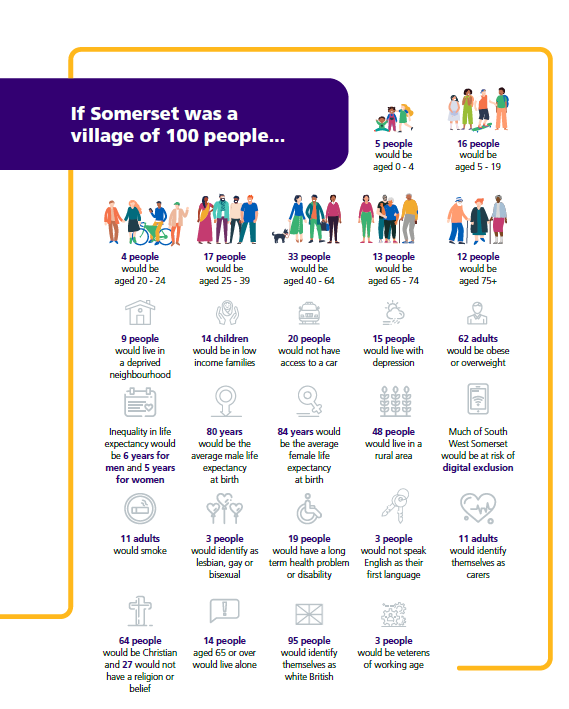Somerset
The 2021 Census showed that Somerset has a population of 571,600, an increase of around 41,600 people since 2011. About half of the population live in rural areas, and the rest in small to medium sized towns and villages. Taunton is the largest urban area with a population of approximately 70,000 people.
Our population profile is older than the England average, with 25% being over 65. Over the next 25 years we expect a significant rise in our older population, with a doubling in the proportion of those over 75, compared with an overall population rise of 15%.
Somerset has less deprivation than the England average. Approximately 10% of the Somerset population fall into the England Core 20 most deprived group, which are mainly centred in urban areas. There is a lot of rural deprivation which is not as extreme but exacerbated by poor transport and access to services, and digital exclusion, especially in West Somerset and coastal areas.
Somerset is well known for its natural beauty. It has rolling hills, the flat plains of the Somerset Levels, and a 25 mile stretch of the South West Coastal path. Particular attractions include Cheddar Gorge in the Mendip area, Exmoor National Park and four hill ranges, the Mendips, Blackdowns, Brendons and Quantocks. Glastonbury Festival is an international musical highlight, and sees an influx of approximately 210,000 staff and visitors during June. Bridgwater is also home of the largest illuminated carnival in Europe, a spectacle that brings thousands of people into the county every year in November. The competitive carnival circuit covers most of the county and raises significant funding for local charities. The carnival clubs are a social focus for many communities throughout the year.
Public Health Status
Life expectancy in Somerset is above the national average and premature mortality rates are lower, although on average the last 17 years are spent in ill health. Even though this shows a good picture of people’s health, the health indicators at different ages are mixed. In West Somerset, the ageing population means that people are living longer and healthier lives, but this also puts more pressure on the health and care system over time.
Children and young people: Health indicators for children and young people in Somerset present a mixed picture. With infant mortality similar to the England average, fewer low birth weight babies than the national average, good oral health in five-year olds (Somerset 17.5% decay v 23.4% England), and a lower than average proportion of children overweight than average in year 6. There are more concerning indicators among older children and adolescents, with hospital admissions caused by unintentional and deliberate injuries in children (aged 0 to 14 years) and young people (15 to 24) significantly above the England average. And emergency admissions for intentional self-harm (Somerset 289.2 per 100k) significantly worse than nationally (England 181.2).
Mental health is a further concern among adults, deaths from suicide are much higher than the national average (Somerset 14.3 per 100k, England 10), and admissions due to alcohol are significantly worse that the England average. It is estimated that whilst about three out of four people with physical illness receive treatment but only one in four people with mental health problems do.
Adult health is particularly affected by the ageing population. The number of people with dementia is likely to double by 2035 to around 18,000. Only about 54% of the estimated cases are diagnosed compared to 62% nationally. Further to this, emergency hospital admissions due to falls in people aged 65 to 79 are lower than the England average but higher among those aged over 80.
What is a Joint Strategic Needs Assessment?
A JSNA is a statutory responsibility (a legal ‘must do’) for all Health and Wellbeing Boards, including the Somerset Board. It brings together information and evidence to give us a well-rounded picture of what it is like to live in Somerset. It examines the health and care needs of the whole population to give a local context for health and social care service planning.
A JSNA identifies:
- The wider social factors that can have an impact on people’s health and wellbeing including housing, education, employment and the environment
- Health inequalities, disparities and deprivation
- Key issues for the whole county such as rurality, climate, fuel poverty, transport and an ageing population
- Current service provision
- Gaps in health and care services, documenting unmet need
- The views and experiences of local people
Who is the JSNA for?
The main audience for a Joint Strategic Needs Assessment (JSNA) is the Somerset Board, who use it in strategy development. Health and social care commissioners also use it to help plan services. However, JSNA can also be used as a source of evidence to support funding bids and business cases. This includes within the voluntary and community sectors, for educational and communication projects and by other professional and lay people who wish to get a more in-depth understanding of their local area.
How we ensure our Joint Strategic Needs Assessments are fit for purpose
Somerset’s JSNAs have become an online information resource with webpages that now provide automatically updated information through Power BI software.
This helps us keep information up-to-date and useful for our new Somerset Council and NHS Somerset colleagues, as well as a wider group of stakeholders and individuals.
